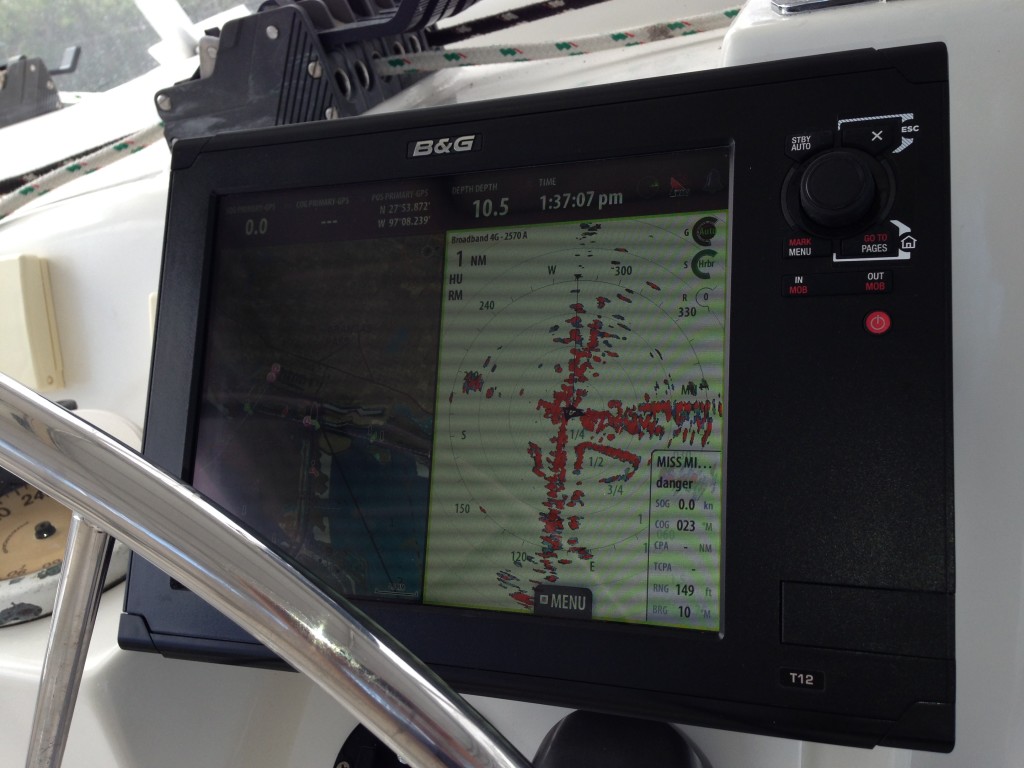Navigation Refit – The Story behind the pretty chart plotter!
When Michelle and I bought Double Wide in 2005, we knew the navigation system, auto pilot, and radar was ready to be replaced, but I figured I’d bandaid the systems along until we were ready to do some more serious cruising. Over the years, we’ve made 8 Gulf of Mexico crossings and along the way, we’ve struggled with multiple failures, including an auto pilot failure on day 1 of a crossing from Tavernier Key to Corpus Christi.
Two years ago we went to the Annapolis Boat Show with the specific intent of researching current systems. I was encouraged to find that the price of equipment was far less than I thought it would be. On the other hand, the options were confusing. Ray Marine, Furuno, Simrad, B&G, Garmin, and several others all had great products. To make matters even worse, every cruiser I talked to had a different opinion on the best product. Ultimately, I decided to hold off another year or two, but during our Bahamas Cruise in the spring of 2013, it became painfully obvious that we had to do something.
Most of the products today use a standard method of communications called NMEA 2000. All NMEA 2000 compatible systems basically talk the same language and support a true “Plug & Play” technology. Most brands use a standard wiring topology (Ray Marine and Simrad have their own, non-standard connectors, but they’re still NMEA 2000 compatible) which allows you to quickly put together a network by simply plugging instruments in to a network backbone.
There has been a bunch of consolidation in the industry over the past few years, so the options really came down to Ray Marine, Navico (B&G), Garmin, or some combination thereof. Ultimately, I decided to buy primarily B&G, partially because our old system was B&G and also because I felt the B&G chart plotter offered a number of features specifically for sailboats that the competitors didn’t offer.
Here’s the list of items I bought:
-B & G Zeus Touch T12 Touchscreen, Multifunction Display
-B & G Triton Digital Display T41 (3 of them)
-B & G ZG100 External GPS Antenna Package
-B & G Broadband 4G Radar Kit
-B & G Triton Speed / Depth Package
-Simrad Auto Pilot – AC 42 Computer, Rate Compass, Rudder Feedback Unit
-Simrad HLD2000 MK2L Linear Pump Drive For AC42 Auto Pilot
-Simrad AP24 Autopilot Display
-Simrad GoFree WIFI-1 Module (control of Touch 12 from an iPad/iPhone)
-Airmar WS-200WX WeatherStation Instrument (no moving parts!)
-To this, I hooked up my existing AIS Class B transceiver and Icom DSC VHF radio.
I couldn’t find an electronics shop here in Texas that I felt comfortable with, so after some encouragement from friends, I decided to install the instruments myself. I was able to remove the old system, run the NMEA 2000 backbone, and install the instruments in about 6 days of work. Plus, I pulled about 30 pounds of old wire out of the boat and I was able to clean up the remaining wires and get everything labeled so that it all makes sense now and in the future.
I am so glad that I took this project on myself. This NMEA 2000 technology is dead simple. When you plug an instrument in, the rest of the network sees it immediately and knows what to do with it. It was so simple and it didn’t take any special skills to complete. Plus, since I ran every wire and connected every instrument, I know where everything is and how it works.
The entire system set me back about $13,500, which is much cheaper than I thought it would be. Since I’ve owned Double Wide I have fought to keep my old B&G system up and running and I can’t believe I haven’t done this sooner.
I’ll have an opportunity to put the new system to a good test in early January as I make a winter Gulf crossing, headed to Florida. 



